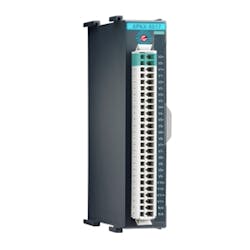New Series of RTD and High Speed Analog Input Modules
These new modules provide advanced functionality for factory production, data acquisition, environment monitoring and facility monitoring applications.
The APAX-5013 is designed for temperature data acquisition featuring high accuracy to identify temperature information and wire burn-out detection through highest and lowest default parameter settings, which can take action in the event the RTD sensor fails. The APAX-5017H has 12-channel high density I/O points, featuring high sampling rates with 1,000 samples a second per channel. The input type of each channel is configurable by different range of voltage and current respectively, including 0~500mV, +-10 V, 0~10V, 0~20mA, 4~20mA. Both the APAX-5013 and APAX-5017H support hot swap capability to reduce downtime and maintain costs.
For more information or to purchase, please contact Advantech directly or your regional Advantech authorized distributor.
Advantech Corporation - www.advantech.com/ea

